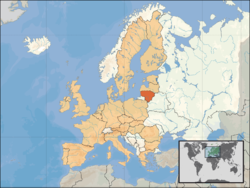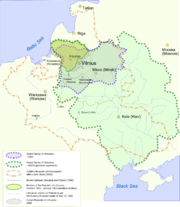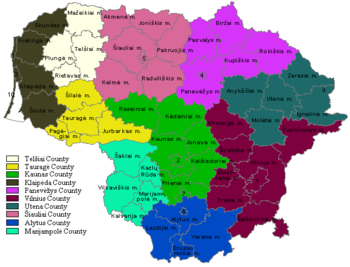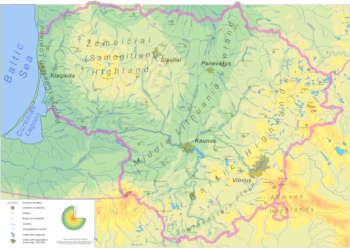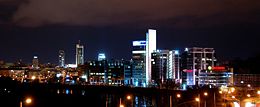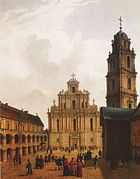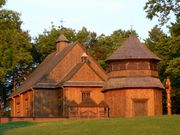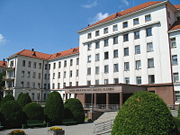Lithuania
2008/9 Schools Wikipedia Selection. Related subjects: Europe; European Countries
| Lietuvos Respublika Republic of Lithuania
|
||||||
|---|---|---|---|---|---|---|
|
||||||
| Motto: "Tautos jėga vienybėje" "The strength of the nation lies in unity" |
||||||
| Anthem: Tautiška giesmė |
||||||
|
Location of Lithuania (orange)
– on the European continent (camel & white) |
||||||
| Capital (and largest city) |
||||||
| Official languages | Lithuanian | |||||
| Demonym | Lithuanian | |||||
| Government | Parliamentary republic | |||||
| - | President | Valdas Adamkus | ||||
| - | Prime Minister | Gediminas Kirkilas | ||||
| - | Seimas Speaker | Česlovas Juršėnas | ||||
| Independence | from the Russian Empire (1918) | |||||
| - | Lithuania mentioned | February 14, 1009 | ||||
| - | Statehood | July 6, 1253 | ||||
| - | Personal union with Poland | February 2, 1386 | ||||
| - | Polish-Lithuanian Commonwealth declared | 1569 | ||||
| - | Russian/Prussian occupation | 1795 | ||||
| - | Independence declared | February 16, 1918 | ||||
| - | 1st Soviet occupation | June 15, 1940 | ||||
| - | 2nd Soviet occupation | 1944 - 1945 | ||||
| - | Independence restored | March 11, 1990 | ||||
| EU accession | 1 May 2004 | |||||
| Area | ||||||
| - | Total | 65,200 km² ( 123rd) 25,173 sq mi |
||||
| - | Water (%) | 1,35% | ||||
| Population | ||||||
| - | 2007 estimate | 3,369,600 ( 130th) | ||||
| - | Density | 52/km² ( 120th) 134/sq mi |
||||
| GDP ( PPP) | 2008 estimate | |||||
| - | Total | $66 billion ( 75th) | ||||
| - | Per capita | $19, 730 ( 49th) | ||||
| GDP (nominal) | 2008 IMF April estimate | |||||
| - | Total | $48, 132 billion ( 75th) | ||||
| - | Per capita | $14, 273 ( 53rd) | ||||
| Gini (2003) | 36 (medium) | |||||
| HDI (2007) | ▲ 0.862 (high) ( 43rd) | |||||
| Currency | Lithuanian litas (Lt) ( LTL) |
|||||
| Time zone | EET ( UTC+2) | |||||
| - | Summer ( DST) | EEST ( UTC+3) | ||||
| Internet TLD | .lt1 | |||||
| Calling code | +370 | |||||
| 1 | Also .eu, shared with other European Union member states. | |||||
Lithuania, officially the Republic of Lithuania ( Lithuanian: Lietuvos Respublika) is a country defined as being part of Northern Europe. Situated along the south-eastern shore of the Baltic Sea, sharing borders with Latvia to the north, Belarus to the southeast, Poland, and the Russian exclave of the Kaliningrad Oblast to the southwest. Lithuania is a member of NATO and of the European Union. Its population is 3.4 million. The largest city and capital is Vilnius.
During the 1300s, Lithuania was the largest country in Europe, as present-day Belarus, Ukraine, and parts of Poland and Russia were territories of the Grand Duchy of Lithuania. With the Lublin Union of 1569 Poland and Lithuania formed a new state: the Polish–Lithuanian Commonwealth, which was finally destroyed by its neighboring countries in 1795. Most of Lithuania's territory was annexed by the Russian Empire, until the Act of Independence was signed on February 16, 1918, which declared re-establishment of a sovereign state. Between 1940 and 1945 Lithuania was occupied by both the Soviet Union and Nazi Germany at different times. When World War II was near its end in 1944 and the Nazis retreated, Lithuania would again be merged into the Soviet Union. On March 11, 1990, Lithuania became the first Soviet republic to declare its renewed independence.
Present-day Lithuania has one of the fastest growing economies in the European Union. Lithuania became a full member of the Schengen Agreement on 21 December 2007. In 2009, Lithuania will celebrate the millennium of its name.
History
The first mention of Lithuania is found in a medieval German manuscript, the Quedlinburg Chronicle, on 14 February 1009. The Lithuanian lands were united by Mindaugas in 1236, and neighbouring countries referred to it as "the state of Lithuania". The official coronation of Mindaugas as King of Lithuania was on July 6, 1253, and the official recognition of Lithuanian statehood as the Kingdom of Lithuania.
During the early period of the Gediminas (1316–1430), the state occupied the territories of present-day Belarus, Ukraine, and parts of Poland and Russia. By the end of the fourteenth century, Lithuania was the largest country in Europe, and was also the only remaining pagan state. The Grand Duchy of Lithuania stretched across a substantial part of Europe, from the Baltic to the Black Sea. Lithuanian nobility, city dwellers and peasants accepted Christianity in 1386, following Poland's offer of its crown to Jogaila, the Grand Duke of Lithuania. Grand Duke Jogaila was crowned King of Poland on February 2, 1386. Lithuania and Poland were joined into a personal union, as both countries were ruled by the same Gediminas branch, the Jagiellon dynasty.
In 1401, the formal union was dissolved as a result of disputes over legal terminology, and Vytautas, the cousin of Jogaila, became the Grand Duke of Lithuania. Thanks to close cooperation, the armies of Poland and Lithuania achieved a great victory over the Teutonic Knights in 1410 at the Battle of Grunwald, the largest battle in medieval Europe.
A royal crown had been bestowed upon Vytautas in 1429 by Sigismund, the Holy Roman Emperor, but Polish magnates prevented his coronation by seizing the crown as it was being brought to him. A new crown was ordered from Germany and another date set for the coronation, but a month later Vytautas died as the result of an accident.
As a result of the growing centralised power of the Grand Principality of Moscow, in 1569, Lithuania and Poland formally united into a single state called the Polish–Lithuanian Commonwealth. As a member of the Commonwealth, Lithuania retained its institutions, including a separate army, currency and statutory law which was digested in three Statutes of Lithuania. In 1795, the joint state was dissolved by the third Partition of the Commonwealth, which forfeited its lands to Russia, Prussia and Austria, under duress. Over ninety percent of Lithuania was incorporated into the Russian Empire and the remainder into Prussia.
Many Jews fled Lithuania following persecution and followed opportunities that lay overseas.
After a century of occupation, Lithuania re-established its independence on February 16, 1918. The official government from July through November 1918, was quickly replaced by a republican government. From the outset, the newly-independent Lithuania's foreign policy was dominated by territorial disputes with Poland (over the Vilnius region and the Suvalkai region) and with Germany (over the Klaipėda region or Memelland). Most obviously, the Lithuanian constitution designated Vilnius as the nation's capital, even though the city itself lay within Polish territory as a result of a Polish invasion. At the time, Poles and Jews made up a majority of the population of Vilnius, with a small Lithuanian minority of only 2%. In 1920 the capital was relocated to Kaunas, which was officially designated the provisional capital of Lithuania. (see History of Vilnius for more details).
In June 1940, around the beginning of World War II, the Soviet Union occupied and annexed Lithuania in accordance with the Molotov-Ribbentrop Pact. A year later it came under German occupation. After the retreat of the German armed forces ( Wehrmacht), Lithuania was re-occupied by the Soviet Union in 1944.
From 1944–1952 approximately 100,000 Lithuanians participated in partisan fights against the Soviet system and the Red Army. More than twenty thousand partisans (" forest brothers") were killed in those battles and many more were arrested and deported to Siberian GULAGs. Lithuanian historians view this period as a war of independence against the Soviet Union.
During the Soviet and Nazi occupations between 1940 and 1944, Lithuania lost over 780,000 residents. Among them were around 190,000 (91% of pre-WWII community) of Lithuanian Jews, one of the highest total mortality rates of the Holocaust. An estimated 120,000 to 300,000 were killed by Soviets or exiled to Siberia, while others had been sent to German forced labour camps and/or chose to emigrate to western countries.
Forty-six years of Soviet occupation ended with the advent of perestroika and glasnost in the late 1980s. Lithuania, led by Sąjūdis, an anti-communist and anti-Soviet independence movement, proclaimed its renewed independence on March 11, 1990. Lithuania was the first Soviet republic to do so, though Soviet forces unsuccessfully tried to suppress this secession. The Red Army attacked the Vilnius TV Tower on the night of January 13, 1991, an act that resulted in the death of 13 Lithuanian civilians. The last Red Army troops left Lithuania on August 31, 1993 — even earlier than they departed from East Germany.
On February 4, 1991, Iceland became the first country to recognize Lithuanian independence. Sweden was the first to open an embassy in the country. The United States of America never recognized the Soviet claim to Lithuania, Latvia and Estonia. Russia currently refuses to recognize the occupation of Lithuania, claiming that Lithuanians decided to join the Soviet Union voluntarily, although Russia signed a treaty with Lithuania prior to the disintegration of the USSR which acknowledged Lithuania's forced loss of sovereignty at the hands of the Soviets, thereby recognizing the occupation.
Lithuania joined the United Nations on September 17, 1991, and on May 31, 2001, it became the 141st member of the World Trade Organization. Since 1988, Lithuania has sought closer ties with the West, and so on January 4, 1994, it became the first of the Baltic states to apply for NATO membership. On March 29, 2004, it became a NATO member, and on May 1, 2004, Lithuania joined the European Union.
Politics
Since Lithuania declared independence on March 11, 1990, it has maintained strong democratic traditions. In the first general elections after the independence on October 25, 1992, 56.75% of the total number of voters supported the new constitution. There were heavy debates concerning the constitution, especially the role of the president. Drawing from the interwar experiences, many different proposals were made ranging from a strong parliamentary government to a presidential system similar to the one in the United States. A separate referendum was held on May 23, 1992 to gauge public opinion on the matter and 41% of all the eligible voters supported the restoration of the President of Lithuania. Eventually a semi-presidential system was agreed upon.
The Lithuanian head of state is the President, elected directly for a five-year term, serving a maximum of two consecutive terms. The post of president is largely ceremonial; main policy functions however include foreign affairs and national security policy. The president is also the military commander-in-chief. The President, with the approval of the parliamentary body, the Seimas, also appoints the prime minister and on the latter's nomination, appoints the rest of the cabinet, as well as a number of other top civil servants and the judges for all courts. The judges of the Constitutional Court (Konstitucinis Teismas), who serve nine-year terms, are appointed by the President (three judges), the Chairman of the Seimas (three judges) and the Chairman of the Supreme Court (three judges). The unicameral Lithuanian parliament, the Seimas, has 141 members who are elected to four-year terms. 71 of the members of this legislative body are elected in single constituencies, and the other 70 are elected in a nationwide vote by proportional representation. A party must receive at least 5% of the national vote to be represented in the Seimas.
Counties, municipalities, and elderates
The current administrative division was established in 1994 and modified in 2000 to meet the requirements of the European Union. Lithuania has a three-tier administrative division: the country is divided into 10 counties (Lithuanian: singular — apskritis, plural — apskritys) that are further subdivided into 60 municipalities (Lithuanian: singular — savivaldybė, plural — savivaldybės) which consist of over 500 elderates (Lithuanian: singular — seniūnija, plural — seniūnijos).
The counties are ruled by county governors (Lithuanian: apskrities viršininkas) appointed by the central government. They ensure that the municipalities adhere to the laws of Lithuania and the constitution. County government oversees local governments and their implementation of the national laws, programs, and policies.
Municipalities are the most important unit. Some municipalities are historically called "district municipalities", and thus are often shortened to "district"; others are called "city municipalities", sometimes shortened to "city." Each municipality has its own elected government. In the past, the election of municipality councils occurred once every three years, but it now takes place every four years. The council elects the mayor of the municipality and other required personnel. The municipality councils also appoint elders to govern the elderates. There is currently a proposal for direct election of mayors and elders, however that would require an amendment to the constitution.
Elderates are the smallest units and they do not play a role in national politics. They were created so that people could receive necessary services close to their homes; for example, in rural areas the elderates register births and deaths. They are most active in the social sector: they identify needy individuals or families and distribute welfare or organise other forms of relief.
The current system of administrative division receives frequent criticism for being too bureaucratic and ineffective. Significant complaints have been made about the number of counties, since they do not have much power. One proposal is to create four lands, a new administrative unit, the boundaries of which would be determined by the ethnographic regions of Lithuania. The benefit would be that the lands would follow natural boundaries, rather than being defined by bureaucrats or politicians. Another of the proposed solutions involves reducing the number of counties so that there would be five in total, each based in one of the five largest cities with populations of over 100,000. Others complain that elderates have no real power and receive too little attention; they could potentially become local initiative communities which could tackle many rural problems.
Geography
Lithuania is situated in Northern Europe. It has around 99 kilometres (61.5 mi) of sandy coastline, of which only about 38 kilometres (24 mi) face the open Baltic Sea and which is the shortest among the Baltic Sea countries; the rest of the coast is sheltered by the Curonian sand peninsula. Lithuania's major warm-water port, Klaipėda, lies at the narrow mouth of the Curonian Lagoon (Lithuanian: Kuršių marios), a shallow lagoon extending south to Kaliningrad. The main river, the Neman River, and some of its tributaries carry international shipping vessels.
The Lithuanian landscape has been smoothed by glaciers. The highest areas are the moraines in the western uplands and eastern highlands, none of which are taller than 300 metres (1,000 ft) above sea level, with the maximum elevation being Aukštojas Hill at 294 metres (964 ft). The terrain features numerous lakes, Lake Vištytis for example, and wetlands; a mixed forest zone covers 30% of the country. The climate lies between maritime and continental, with wet, moderate winters and summers. According to one geographical computation method, Lithuania's capital, Vilnius, lies only a few kilometres south of the geographical centre of Europe.
Phytogeographically, Lithuania is shared between the Central European and Eastern European provinces of the Circumboreal Region within the Boreal Kingdom. According to the WWF, the territory of Lithuania can be subdivided into two ecoregions: the Central European mixed forests and Sarmatic mixed forests.
Lithuania consists of the following historical and cultural regions:
- Aukštaitija — literally, the "Highlands"
- Samogitia (Lithuanian: Žemaitija) — literally, the "Lowlands"
- Dzūkija (Lithuanian: Dzūkija or Dainava)
- Suvalkija (Lithuanian: Suvalkija or Sūduva)
- Lithuania Minor also known as "Prussian Lithuania" — (Lithuanian: Mažoji Lietuva or Prūsų Lietuva). Region was part of the Prussia since Middle Ages until 1945. Most of it today is part of Russia ( Kaliningrad Oblast).
Economy
In 2003, prior to joining the European Union, Lithuania had the highest economic growth rate amongst all candidate and member countries, reaching 8.8% in the third quarter. In 2004 — 7.3%; 2005 — 7.6%; 2006 — 7.4%; 2007 — 8.8%, 2008 Q1 — 7.0% growth in GDP reflects the impressive economic development. Most of the trade Lithuania conducts is within the European Union.
It is a member of the World Trade Organization, and the European Union. By UN classification, Lithuania is a country with a high average income. The country boasts a well developed modern infrastructure of railways, airports and four lane highways. It has almost full employment, with an unemployment rate of only 2.9%. According to officially published figures, EU membership fuelled a booming economy, increased outsourcing into the country, and boosted the tourism sector. The litas, the national currency, has been pegged to the Euro since February 2, 2002 at the rate of EUR 1.00 = LTL 3.4528, and Lithuania is expected to switch to the Euro on 1 January 2010. There is gradual but consistent shift towards knowledge based economy with special emphasis on biotechnology (industrial and diagnostic), because in Lithuania there are concentrated major biotech producers in the Baltic countries, as well as laser equipment. Also mechatronics and information technology (IT) are seen as perspective knowledge based economy directions in Lithuania.
Like other countries in the region (Estonia, Latvia) Lithuania also has a flat tax rate rather than a progressive scheme. Lithuanian income levels still lag behind the rest of the older EU members, with per capita GDP in 2007 at 60% of the EU average. Lower wages may have been a factor that in 2004 influenced the trend of emigration to wealthier EU countries, something that has been made legally possible as a result of accession to the European Union. In 2006, income tax was reduced to 27% and a reduction to 24% was made in October of 2007. Income tax reduction and 19.1 % annual wage growth is starting to make an impact with some emigrants gradually beginning to come back. The latest official data show emigration in early 2006 to be 30% lower than the previous year, with 3,483 people leaving in four months.
Education
Vilnius University is one of the oldest universities in Northern Europe and the largest university in Lithuania. Kaunas University of Technology is the largest technical university in the Baltic States and the second largest university in Lithuania. Other universities include Kaunas University of Medicine, Lithuanian Academy of Music and Theatre, Vytautas Magnus University, and Mykolas Romeris University.
Transport
Klaipėda port is the only port in Lithuania.
Vilnius International Airport is the largest airport. It served 1.7 million passengers in 2007.
Energy
Ignalina Nuclear Power Plant is a Soviet-era nuclear station. Unit #1 was closed in December 2004, as a condition of Lithuania's entry into the European Union; the plant is similar to the Chernobyl Nuclear Power Plant in its lack of a robust containment structure. The remaining unit, as of 2006, supplied about 70% of Lithuania's electrical demand. Unit #2 is tentatively scheduled for closure in 2009. Proposals have been made to construct another nuclear power plant in Lithuania.
Demographics
Ethnic composition
The population of Lithuania stands at 3.3662 million, 84.6% of whom are ethnic Lithuanians who speak the Lithuanian language (one of the two surviving members of the Baltic language group), which is the official language of the country. Several sizable minorities exist, such as Poles (6.3%), Russians (5.1%), and Belarusians (1.1%).
Poles are the largest minority, concentrated in southeast Lithuania (the Vilnius region). Russians are the second largest minority, concentrated mostly in two cities. They constitute sizeable minorities in Vilnius (14%) and Klaipėda (28%), and a majority in the town of Visaginas (52%). About 3,000 Roma live in Lithuania, mostly in Vilnius, Kaunas, and Panevėžys; their organizations are supported by the National Minority and Emigration Department.
Most Lithuanian schools teach English as a first foreign language, but students may also study German, or, in some schools, French. Schools where Russian and Polish are the primary languages of education exist in the areas populated by these minorities.
Religion
In 2005 79% of Lithunians belonged to the Roman Catholic Church. The Church has been the majority denomination since the Christianisation of Lithuania in the end of fourteenth century and beginning of fifteenth century. Some priests actively led the resistance against the Communist regime (symbolised by the Hill of Crosses). Church attendance has increased since the end of the Soviet occupation and the country has so far maintained a fairly high level of religious practice.
In the 16th century, Lutheranism started to spread from neighbouring Livonia and East Prussia. In the first half of 20th century Lutheran Protestant church had around 200,000 members, 9% of total population, although Lutheranism has declined since 1945. Small Protestant communities are dispersed throughout the northern and western parts of the country. Various Protestant churches have established missions in Lithuania since 1990.
4.9% are Eastern Orthodox (mainly among the Russian minority), 1.9% are Protestant and 9.5% have no religion. The country also has minority communities of Judaism, Islam, and Karaism which make up another 1.6% of the population. According to the most recent Eurobarometer Poll 2005, 49% of Lithuanian citizens responded that "they believe there is a God", 36% answered that "they believe there is some sort of spirit or life force" and 12% that "they do not believe there is any sort of spirit, god, or life force".
Health and welfare
As of 2004 Lithuanian life expectancy at birth was 66 years for males and 78 for females. The infant mortality rate was 8.0 per 1,000 births. The annual population growth rate in 2004 declined by 0.5% in 2004. Less than 2% of the population live beneath the poverty line, and the adult literacy rate is 99.6%.
Lithuanians have a high suicide rate: 91.7 per 100,000 persons, the highest in the world in 2000, followed by the Russian Federation (82.5), Belarus (73.1), Latvia (68.5), and Ukraine (62.1). This problem has been studied by a number of health organisations.
Largest cities
| City | Region | Population | Density* (/km²) | Area (km²) |
|---|---|---|---|---|
| Vilnius | East | 544,091 | 1,379 | 401 |
| Kaunas | Middle | 355,550 | 2,319 | 157 |
| Klaipėda | West | 184,684 | 1,926 | 98 |
| Šiauliai | North | 127,043 | 1,605 | 81 |
| Panevėžys | North | 113,668 | 2,236 | 52 |
| Alytus | South | 68,315 | 1,747 | 40 |
| Marijampolė | South | 47,014 | 2,271 | 21 |
| Mažeikiai | North | 40,572 | 2,956 | 14 |
| Jonava | Middle | 34,436 | ||
| Utena | East | 32,569 | 2,191 | 15,1 |
* Population density.
Culture
- List of famous Lithuanians
- Lithuanian literature
- Lithuanian mythology
- Music of Lithuania
- Symbols of Lithuania


